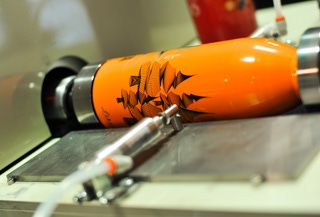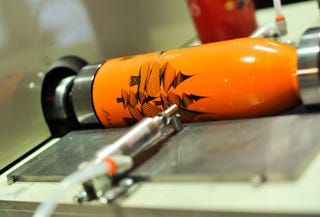Digital presses create art in the round
January 30, 2014


inx
There are no bottles like these made anywhere else in the world, and that suits Ryan Clark just fine. Along with company founder Tim Andis and 35 employees of Liberty Bottleworks in Union Gap, WA, evp Clark touts "exclusive" in numerous aspects of this firm and its products: aluminum water bottles graced by artwork.
Not just any aluminum and not just any artwork, and certainly not the usual screen-printed production technology. The multicolored Liberty bottles are digitally printed with specially formulated UV LED inks on a rapidly growing cadre of CP100 cylindrical printers from INX Intl. Ink Co. Liberty began production with two units late in 2010. It added a third, then a fourth in March, and had four more delivered by the end of summer, bringing the total to eight.
"We're printing things on our bottles that you simply can't do with traditional silk screening," Clark says. "The color reproduction as well as the textural quality is unmatched anywhere. This isn't mere four-color screen-printed imagery; we're laying down high-resolution graphics-up to 1,000 dpi 6-pass photographs. On bottles with topographic map artwork, you can see every ridgeline name, every elevation change and feel the rivers. It's like high-definition graphic Braille. We couldn't do it without this digital process and these printers."
The INX CP100s are just one new item-Liberty Bottleworks itself is new. Founder Andis and Clark, the firm's first employees, turned a 35,000-sq-ft facility into a thriving manufacturing plant in little more than a year. Located in the Yakima Valley near the route first mapped by explorers Lewis and Clark (no relation) in the early 1800s, theirs is a pioneering, entrepreneurial enterprise in spirit and in practice, with a teamwork perspective that extends to the leading-edge printers which are, as Clark puts it, "on the payroll."
Shattering the screen barrier
Liberty's first two CP100s arrived before the rest of the factory production line was fully operational. One was configured to print 24 oz bottles, but was quickly converted to 32 oz to ramp up output of the larger size. When bottle production started in earnest, the two printers quickly stepped up to three shifts a day, six days a week.
Both units soon were given nicknames by Liberty employees based on their "personalities" and performance, according to Clark. "Bruce is named for movie star Bruce Willis, specifically his never-say-die character from the ‘Die Hard' series. You can't kill our Bruce. We run him literally 24 hours a day, Monday through Saturday. He shows up every day, keeps doing the job and you can't hurt him.
"Jane's name evolved from a few initial production issues-not with the printer, but due to self-inflicted problems caused by our people working with new technology. This created ‘calamities' which disappeared, once we remedied our own issues. In the process, the CP100's name went from ‘Calamity' Jane to the movie's ‘GI Jane,' an underdog who at first couldn't keep up, but now proves that she's every bit as capable on a daily basis."
More recent arrivals are proving no less productive, but haven't yet been given permanent names until their personalities become clear.
One-of-a-kind products
"Ours is a ‘green' factory," says Clark. "Our state-of-the-art equipment minimizes energy use, cleans our wastewater and conserves resources. And the way we make our bottles has never been done elsewhere. Rather than cold forging, we use a deep-drawn manufacturing process that compresses and then elongates the aluminum. The bottles are finished with a BPA-free, food-grade powder coat, which gives bottle walls a consistent thickness and creates a stronger, more durable, reusable container."
The aluminum itself is 100 percent recycled material, not the 30 percent minimum content used for most "recycled" aluminum products, Clark points out. "We even recycle our own scrap, and melt it down to make more Liberty bottles. The UV inks we use are made without VOCs."
Liberty bottles offer another plus for end-use consumers: a unique cap (patent pending) that requires only about a quarter-turn to open, rather than the typical half-dozen. "Little things like this are a big deal to us," says Clark. "Such details set our bottles further apart from the rest."
The company's first major shipment, to REI (Recreational Equipment Inc.), was made at the end of 2010. They were running about 30,000 bottles a week in March. "We're still filling back orders and selling bottles as fast as we can turn them out. We'll be adding a second production line and more employees when the last four printers arrive, and we'll start turning out quantities of 24 oz. bottles along with the 32 oz. size, which retail at $16 and $18, respectively."
In addition to REI, Clark says the company is lining up distribution with a number of the nation's largest retailers not only in sporting goods, but chains such as Whole Foods, which already carries Liberty bottles. They are also available on Amazon.com.
Bottles are dishwasher safe
"Ours are the only truly dishwasher-safe water bottles on the market," Clark adds. "They're also totally BPA-free, on the inside as well as the outside. Unlike conventional inks and other print processes in which BPA is used to help ink adhere to the bottle, we wanted no BPA whatsoever in our products."
This created adhesion issues for Liberty and ultimately led to one-of-a-kind UV LED ink sets, specially developed by INX Digital ink specialists.
"Initially, we could get the ink on the bottles, and it looked beautiful," Clark reveals. "But it had to hold up in a dishwasher. INX cracked the code, and they nailed it. They developed a special, modified chemistry in the coating that goes down first. You can't scratch or chip the ink off and it's permanently bonded to the bottles. The print quality is impeccable. There's no way you could silk screen on metal what we're doing. We have one bottle with 256 shades of gray and with our Mass Transit collection, you can see every stop and read the name."
Custom capability resonates
The designs and art printed on Liberty bottles are highly diverse as well as original, with most collections created by commissioned artists.
"Our goal is to build a company that does well by doing good, and to impact as many lives in a positive manner as we can," Clark explains. "Working with and supporting artists is one way to do it."
Liberty people canvassed area art fairs and music festivals to find independent artists whose work they liked, then invited them to turn some of their work into "Art in the Round," for a collection to be cylindrically printed on Liberty bottles. The response was overwhelming.
"Each artist submits 10 pieces from which we choose six," says Clark. "We work with them to ensure that each selection will work in the round, and on how to drop out colors to utilize the color of the bottle as part of the image, which also adds a greater textural component to the bottle."
Liberty changes artists twice a year and at this point, they're producing nine collections. Each artist receives part of the proceeds from every bottle sold with their artwork on it.
Handling the variety of bottle designs also points up how the CP100 printers enable Liberty to provide customized printing in short-run quantities unheard in screen printing operations.
"If someone wants their logo or a special design on only one SKU, we can run those 72 bottles and still make money," Clark claims. "This gives us a value-added service to offer many smaller, independent retailers. It also makes it easy to run large quantities for major corporate clients. INX digital technology allows us to shift gears real quick."
The decision by Clark and Andis to go digital and their choice of INX CP100s didn't happen overnight. Clark visited a number of non-water bottle makers to investigate "safe, standard" screen printing technology, before going on to investigate digital further. "Everyone told me that digital printing was neat, but that it wasn't there yet and would never be a production tool," Clark recalls.
So he visited INX's facility in Huntsville, AL, to see for himself. "The CP100 wasn't quite ready for me to take home, but I saw what these machines could do, and thought it could work for us."
More importantly, Clark emphasizes, "I was really impressed with Jim Lambert (vp, Digital Division of INX Intl.) and his team of engineers, software programmers and specialists. I called Tim (Andis) from the Huntsville airport. He asked what I thought and I told him if anyone can figure this out, these guys can. I feel really comfortable with the INX team.
"We just figured let's do it. No one else is, and the world doesn't need another screen-printed water bottle. I thought we'd use technology that's unique and new, and in-tune with the unique properties of our bottle and our company."
Clark called Lambert immediately with the news. "Jim hadn't expected this response so soon," Clark recalls. "He even asked if we might want to initially get just one CP100 plus a screen set-up as a contingency backup. I told him that we're saddling only one horse for this race and it was his, so get ready to run fast. We've been running together ever since."
Noting that Bruce and Jane and their latest digital cohorts "are wonderful machines," Clark says they will get even better as INX continues to advance CP100 digital technology. The newer printers run 30 percent to 40 percent faster than the initial units.
INX Intl. Ink Co., 800-631-7956.
www.inxinternational.com
About the Author(s)
You May Also Like


